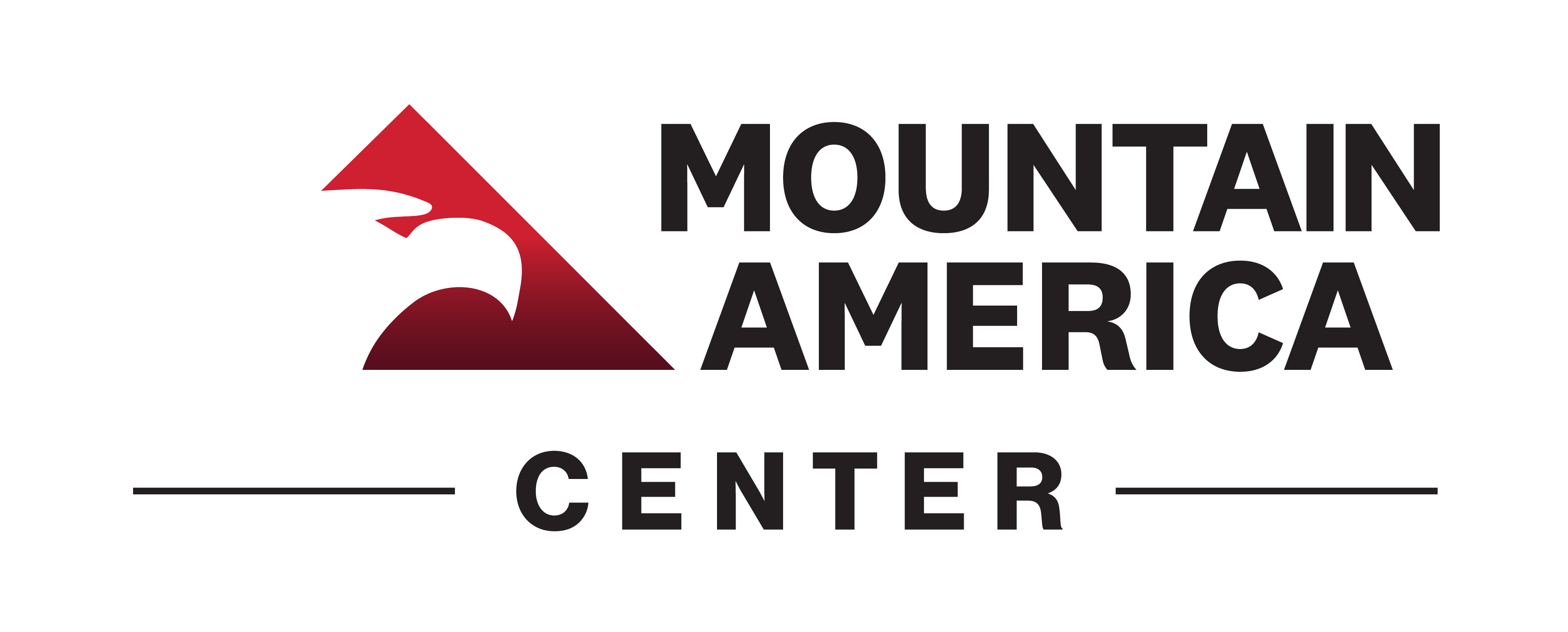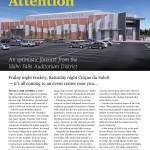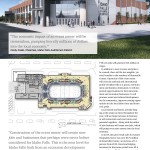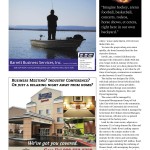History
2007
December: The Greater Idaho Falls Chamber of Commerce retained Economics Research Associates (ERA), a premier land use policy and planning consultant, to prepare an independent financial feasibility study, economic impact analysis and site selection for a proposed multi-purpose event center to be located in Idaho Falls, Idaho.
December 2007: Economics Research Associates (ERA) retained to prepare a feasibility study
2008
February: ERA interviewed stakeholders including businesses, hotels, restaurants, event promoters, retailers and city leaders to determine the wants and needs of the community (job creation, business development opportunities, quality of life enhancement, etc.).
August: ERA completed analysis and reported findings to the Idaho Falls Chamber of Commerce Board of Directors. The findings determined the City of Idaho Falls has the necessary infrastructure, population size, income and overall demographics to support a regional multi-purpose event center with an anchor tenant to bring in conventions, trade shows, concerts, professional sports, youth sporting events and family shows. A link to the study can be found here: ERA Final Report
August 2008: ERA completes first feasibility study
September: Based on the strong results from this study, the Chamber Board was tasked with establishing an advisory committee to further evaluate the data, funding options and necessary requirements to establish an Event Center.
2009
January: After months of deliberation into the makeup of the committee and defining their objective, an advisory committee was selected from potential user groups: individuals with skills in land use management, architecture, economic development, construction, and legal authority. The advisory committee determined research and analysis would be conducted on four major components in the creation of a multi-use event center. 1) Where will the Event Center be built? 2) What will the Event Center look like and what functions can it provide to the community? 3) How much will the Event Center cost? and 4) How will the Event Center be funded?
LOCATION:
1) Where will the Event Center be built
March: A press release invited community members to suggest sites and local landowners to submit proposals of properties to be considered. Each proposal detailed the practicality of each site, as well as the ability to meet general criteria such as: 1) access to utilities; 2) vehicle access; 3) road and infrastructure costs; 4) site exposure; and 5) overall image.
May: Twelve sites were submitted with locations ranging from large green fields, Historic Downtown, the Hotel District (Lindsey Boulevard/Utah Avenue),and developments like Snake River Landing and Sunnyside Crossroads. The advisory committee immediately disqualified two sites due to their lack of infrastructure and the high costs associated with establishing water, sewer, and power to the site. Two additional sites were disqualified due to: a lack of quality access; inadequate parking; multiple owners or parcel assemblage problems; as well as possible demolition or destruction of property with relocation of current facilities. The committee then created a matrix which evaluated the eight remaining sites against the following key criteria:
- Site size for initial program (e.g. building footprint, parking, truck delivery access)
- Site configuration
- Potential expansion area (e.g. additional parking, amenities)
- Site ability to serve current and future demographics
- Multiple ingress/egress opportunities for attendees via automobile, pedestrian/bicycle access
- Ability to link to recreational & park outdoor amenities
- Site ability for Event Center to complement surrounding areas
- Site ability to minimize off-site impacts (i.e. Noise to Residential)
- Site ability to allow for “ideal” Event Center program
- Site exposure and image
- Site solar and wind orientation
- Land availability, ease of acquisition, land cost
- Utility cost/availability
- Road and other infrastructure cost/availability
- Site slope, wetlands, geotechnical/environmental issues
- Site ability to garner community support/consensus
- Site ability for neighborhood enhancement and/or redevelopment
The committee evaluated each site using the matrix and a scoring system.
October: The advisory committee had narrowed the list of sites to the three most promising options. ERA evaluated the three finalist sites using their own independent criteria. They found all three sites to be strong candidates with the Snake River Landing (SRL) site scoring highest. This high score was due to its location, high visibility, and integration into the overall mixed-use development with master-planned elements such as restaurants, retail, theater, office space, pedestrian areas, and significant landscaping. The proposed site consists of a 20.54 acre parcel which provides easy access via I-15, Sunnyside Road, Snake River Parkway, and Pancheri Drive. The aerial view of the property can be found here: EVENTCENTER LOT
VISION:
2) What will the Event Center look like and what functions can it provide to the community?
The goal of the committee was to create a venue that would attract new business and visitors to the community while enhancing the quality of life in the region. They envisioned a facility with a sports team as an anchor tenant. The Event Center would include ice capability sufficient for professional hockey and the flexibility to serve as a convention/conference center, host trade shows, regional sport championships, concerts, entertainment and graduations. The intention of the committee was to attract events not currently accommodated in the region that would compliment local facilities.
COST:
3) How much will the Event Center cost?
Project costs are most often broken down into hard and soft costs. The hard costs are approximately 70% of the total cost for a project such as an event center, which is primarily construction costs. The soft costs make up the remaining 30%. Approximately half of the soft costs are for expenses including architectural and engineering design fees, permitting, fixtures/furniture/equipment, special inspections, financing, legal fees, etc. The other half is mainly land cost. The property will be acquired through a generous land donation from a local business owner. Therefore, the land donation represents a very significant savings to the project. It is not until an Architectural firm is hired and plans are drawn up that a more firm cost estimate is established.
FUNDING:
4) How will the Event Center be funded?
Various funding options will be considered.
October 2009: Chamber of Commerce evaluates several potential construction sites and chooses 20 acres of Snake River Landing as the ideal site.
2010
January: The Greater Idaho Falls Chamber of Commerce sends out a a Request for Qualifications (RFQ) was sent to local and national architectural and engineering firms for a multi-use events center.
April: The Chamber of Commerce Committee selects local architectural firm Cooper, Robertson, Simonsen and Associates (CRSA) and partner Sink Combs Dethlefs Architects to submit concept designs the events center.
- CRSA http://www.crsa-us.com/ has been an integral part of community building throughout the Western Mountain Region since 1975. The firm’s award winning work of creative and innovative urban design, historic preservation, and civic, commercial, cultural and institutional projects can found in large and small communities. Recognized as a leader in community-centered design, their services will include architecture, planning and landscape architecture for the future Idaho Falls Event Center.
- Sink Combs Dethlefs http://www.sinkcombs.com/ is recognized internationally as a leader in multi-use arena and event center design. The mid-sized firm, established in 1962, maintains offices in Chicago and Denver. They have contributed their expertise to dozens of sports and exhibition projects throughout the world, working closely with municipalities, universities and private organizations to create designs that meet the specific needs of owners and users. Their completed centers include Independence Event Center, 1st Bank Event Center, Tim’s Toyota Center and the Wenatchee Town Toyota Center.
May: A press conference begins the petition process of creating an election for development of an auditorium district.
June: CRSA and Sink Combs Dethlefs Architects had determined the size, functional qualities, and preliminary design approach for the Event Center. Study data supported a conservative approach to the number of seats and venue size (5,000 fixed seats) with a projected cost of $35-$40,000,000. This was considered to be a cost conscious approach for a project of this size and square footage including the land donation.
July: The advisory committee began meeting with potential anchor tenants, facility management firms and investors as well as identifying possible construction grants.
2011
March: The petition process for election was completed and filed with the Bonneville County Elections Office. District Judge Dane Watkins authorized an election for Tuesday, May 17, 2011, for the purpose of creating an Auditorium District for the construction of an Event Center. The election resulted in a victory with 63% of voters in favor the Idaho Falls Auditorium District.
May 17, 2011: Citizens of Idaho Falls vote to establish an auditorium district, giving the power to establish a 5% hotel tax (Passed with 63% of vote)
June: Ron Longmore provided the official court order establishing IFAD and conducted the swearing in ceremony for the initial board members who included Cindy Ozaki, Chair, Kris Meek, Vice Chair, Jeff Sayer, Secretary/Treasurer, Bob Everhart and Robb Chiles. The District filed for Treasurer’s surety bond, established a scope of work, and sent out RFQ’s for legal counsel.
June 2011: First Meeting official meeting of the Idaho Falls Auditorium District (IFAD)
July: Legal Counsel was obtained. Resolutions adopted: Resolution 2011-01: Establishing the District, Resolution 2011-02: Hiring Counsel and Resolution 2011-03: Bylaws (IFAD Bylaws).
November: IFAD begins collecting tax revenue to fund construction.
December: The Board met with representatives from Greater Boise Auditorium District (GBAD).
2012
January: Board members toured the Maverik Center in Utah and sent RFQ’s for Accounting services.
February: The Board adopted Policy I: Money Disbursements and Policy II: Travel.
March: The Board met with Pocatello-Chubbuck Auditorium District (PCAD) Board and toured event centers in Prescott, AZ and Rio Rancho, NM.
May: Accounting contract was awarded, web developer identified and the District solicited and reviewed Operator RFQ proposals. A building and planning committee was established and Cindy Ozaki, Chair, was designated spokesperson for the Board of Directors.
June: Building Committee meetings commenced for the discussion of building schematic design. Design considerations include: parking, back-of-house design, suites, meeting room and banquet space, concessions, foot bridges, roof and ceiling height and additional ice space.
August: Centennial Management Group (CMG) was chosen to manage and operate the Idaho Falls Event Center and soil samples were taken at the site.
September: The board designed and selected the logo for the District.
October: Architects reviewed the completed traffic study and IFAD acquired office space in the new Business Development Center. Jeff Sayer resigned as board member. Ms. Terri Gazdik was appointed to fill his vacancy in accordance with statute.
December: Board adopted Policy III: Public Records and began survey and plat work at the site.
2013
January: The board adopted 2013 budget and identified the web domain name as IdahoFallsAuditoriumDistrict.com.
February: The District joined the Greater Idaho Falls Chamber of Commerce. The District received a clean opinion on their annual audit.
March: The City of Idaho Falls Planning and Zoning approved a C-1 designation and an Administrative Coordinator was hired.
May: Ms. Gazdik ran unopposed for the vacant six year seat and Ms. Janet Trujillo was elected to the two year seat previously held by Mr. Bob Everhart.
July: The board approved updated schematic design. Adopted Policy IV: Interaction with Media.
August: Design development began to address aesthetics, design detail, and materials. The current conceptual site design can be found here: IFEC_color Site. The board researched investment options for tax revenue and voted to maintain the FDIC insured amount at a local bank for operating expenses and invested the remaining tax revenue in the Local Government Investment Pool (LGIP).
September – November: Updates and reports on annexation and donation agreement, CMGC legislative issues (Construction Manager/General Contractor), website development. Attended an Open Meetings Law/Public Records Workshop.
December: Board members attended the Bonneville Metro Planning Organization (BMPO) meeting on the Sunnyside Road Access Plan.
2014
January: An approximate 13% increase in gross tax receipts is representative of good growth in the area lodging industry. Chairman Ozaki attended the Chamber Legislative days in Boise.
February: The board adopted 2014 budget. The District received a clean opinion on their annual audit. Chairman Ozaki and Kevin DeKold testified in favor of the CMGC (Construction Manager/General Contractor) bill during Senate Hearing Committee. The bill passed the Senate and was sent to the House.
March: Chairman Ozaki gave testimony in favor of the CMGC bill during the House Hearing Committee. CMGC Legislation passed 64-4-5. CRSA discussed construction scheduling for hockey to be played by fall of 2016. Dirt work, bridges and canal work would be done this calendar year. Discussion and decisions on roads to be determined. Robb Chiles resigned as board member. Mr. Allan Woolley was appointed to fill his vacancy in accordance with statute. Executive Director Search Committee was established.
April: CMGC Legislation signing by Gov. Otter was attended by Cindy Ozaki, Chair, and Kevin DeKold of CRSA. (picture below) The Board participated in the Mayors’ Business Day. District adopted Policy VI: Separation of Duties. District receipts show growth of 9% since first of the fiscal year through the end of February. Further discussion on property annexation.
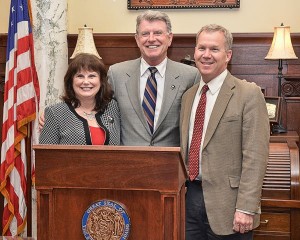
May: Cindy Ozaki, Chair, and Kevin DeKold, CRSA will sit on the State CMGC Rules Process Committee. Discussions with Idaho Transportation Department (ITD) and Grow Idaho Falls on area traffic issues and study. Joined Yellowstone Teton Territory (YTT) to promote tourism in the region. http://www.yellowstoneteton.org/ IFAD website launched. https://www.idahofallsauditoriumdistrict.com/ The Chamber, in collaboration with the District, received a state grant to promote tourism in Idaho Falls.
June: Discussions of area roads, Road Master Plan, and Sunnyside Road Access Plan with CRSA, SRL, Horrocks, and Centennial Management. District receipts show growth of 11.15% increase through the end of April. The District joined Grow Idaho Falls. Hospitality performance indicators from Grow Idaho Falls show that Idaho Falls leisure hospitality is growing in our area and suggests the Event Center would provide a tremendous increase in the County’s Gross Retail Sale in Leisure Hospitality.
July: The District is up 20% over last year in net income. The Executive Director position was posted. Continued discussions on road, site concerns and imminent hiring of USGS local representative. Galusha, Higgins, Galusha, (GHG) presented the hotel audit and noted good compliance.
August: Home2Suites announce construction commencement at SRL in September. Ball Ventures to update Event Center onsite sign with new building design.
September: Yellowstone Teton Territory (YTT) reports that Idaho Falls is up 18% in visits and is looking to secure more state funding for tourism. YTT is already promoting the 2017 solar eclipse. Mr. Everhart filled the open board seat left my Mr. Kris Meek. Bitrick Consulting was hired for the Executive Director search.
November: Mr. Isom announced that Home 2 Suites is building in Snake River Landing and a fall opening is anticipated.
December: The District continues to show positive growth in receipts. Rudd and Company will provide the District audit again this year.
2015
January: Mr. Allan Woolley was elected by the board to fill the vice chair position. District members attended Chamber Legislative Days in Boise. Executive Director, Dave Lane, was hired. See article: http://www.postregister.com/articles/news-todays-headlines-west/2015/01/05/auditorium-district-hires-executive-director
February: Stakeholder and HARN (High Accuracy Reference Network) meetings were held. The District partnered with City, State, and Federal representatives for HARN relocation. Rudd and Company offered an unmodified or ‘clean’ opinion for the 2014 District audit.
March– IFAD reached the $4 million mark in cash reserves.
April– HARN (High Accuracy Reference Network) marker will be removed and relocated at no expense to the District. IFAD and IFEC featured in 2015 East Idaho Business magazine.
May– Mr. Allan Woolley, Mr. Bob Everhart, Mr. Ryan Meikle elected to the IFAD Board of Directors.
June– City of Idaho Falls Planning Commission recommended approval of the event center property annexation into the City. $4.5 million raised.
August– Idaho Falls City Council approves the annexation agreement for Snake River Landing Division No. 9 – the future home of the Idaho Falls Event Center. Annexation Press Release
September– Annexation and plat recorded. Ord3021
Snake River Landing Div 9 Event Center INST 1506842
October – no meetings in October
November – Mr. Bob Everhart resigns from Board after moving from the District.
December – Rudd and Company hired for Audit. Draft budget was presented. 2016 meeting dates approved. 2016 IFAD Board of Directors Meeting Dates
2016
January – Renewed Greater Idaho Falls Chamber of Commerce membership. 2016 Budget adopted. IFAD Budget – 2015-16
February – Dr. Mike Lehto appointed to board to fill vacancy left by Bob Everhart resignation. Lehto Press Release. Idaho Falls Lodging Association reestablished.
March – Clean Audit Report submitted by Rudd & Co. Rep Letter – Idaho Falls Auditorium District – 2015. Centennial presentation.
April –Laura Lewis, Lewis & Young presentation. Revised Construction Estimate provided by Parametrix. Cost Estimate 10-19-2012 Updated 05-26-16
May – IFAD board meeting start time permanently changed from 7:30 a.m. to 7:00 a.m. Memorandum of Understanding reached between IFAD and Centennial Management Company. A Request for Qualifications for a Transient Room Tax Study was released.
June– Memorandum of Understanding reached between IFAD and Laura Lewis, Lewis & Young Financial. A Request for Qualifications for Construction Manager General Contractor (CMGC) was released. Centennial Management Company to commission a Feasibility Study. Idaho Business Review article IFEC – Idaho Business Review article
July – Bateman-Hall Hogan hired as Construction Manager/General Contractor. Hunden Strategic Partners contracted to perform the Transient Room Tax Revenue study.
August – Hunden Strategic Partners preliminary Transient Room Tax presentation. Mr. Ryan Meikle resigns from board after moving from the District.
September – Site canal and road work plans reviewed. Narrative Regarding Plan of Finance presented by Laura Lewis, Lewis & Young Financial. Determination made to not seek Bond approval in November 2016.
October – New Board Member Mr. Mick Ohman appointed to fill vacancy left by Ryan Meikle. Ohman Press Release
November – 2017 Board Meeting dates approved. 2017 IFAD Board of Directors Meeting Dates, 2017 Audit contract approved. 2017 Budget approved.
December – Transient Room Tax Revenue Report completed.
2017
January – Investigation of alternative heat and energy sources
City of Idaho Falls held a Short Term Rental Open House on the 25th
Year end revenues almost 15% ahead of prior year
$7 million raised to date
February – Adoption of policy for Short Term Rentals
Financial Presentation b Laura Lewis, LYRB
Presentation by Greg Weitzel, Director, Parks and Recreation
March – Cindy Ozaki designated the District’s Executive Director
New board applications were opened
$8.5 million raised to date
May – Terri Gazdik was elected Chairman of the Board
Pathways was contracted to conduct a fundraising feasibility study
June – The new Board consisting of Robert Nitschke, Jill Kirkham, Doug Swanson and John Lobuono were sworn in and oaths signed
Training for the new Board Members was conducted
October – Board approves executive search for new Executive Director of the Idaho Falls Auditorium District
2018
January – Board begins interview process of the candidates selected for the Executive Director position.
February 2018 – Brian “Chip” Scott hired as executive director
February 27, 2018 – voted to accept and approve a development agreement with Pioneer Front
Properties, LLC, a subsidiary of Ball Ventures, LLC which confirmed the donation of 23 acres of land located in Snake River Landing, for the construction of a multi-use events center.
February 27, 2018 – selection of Convention Sports & Leisure International (CSL) of Minneapolis, Minnesota as the firm to conduct a new feasibility study on behalf of the District.
April 27, 2018 – Approved a development agreement with Pioneer Front Properties to build a road that would lead up to the future event center.
June 7, 2018 – Second Feasibility Study Completed by CSL
October 2018 – Financial Feasibility study completed by Laura Lewis
October 29, 2018 – Construction begins on Event Center Drive a 5-lane street, which will allow access to the future event center
November 2018 – Pathway Associates hired to assist with naming rights and fundraising
2019
January 2019 – $11 million raised to date
April 2019 – Rob Spear hired as new executive director
July 2019 – Idaho Falls Auditorium District Announces Naming Rights Partnership with Mountain America Bank
2021
February 2021 – Idaho Falls Auditorium District Announces Partnership with Teton Auto Group
April 2021 – Idaho Falls Auditorium District Announces Partnership with Bingham Healthcare
May 2021 – Idaho Falls Auditorium District Announces Partnership with Golden Valley Natural
May 2021 – Groundbreaking
June 2021 – Partnership with Blue Cross of Idaho for New Conference Center Announced
October 2021 – First tilt panels raised
December 2021 – Tilt Panel process completed

